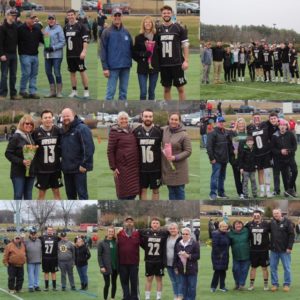By David Furtado
Mark Nason is the Radio Director for WHSN located at Husson University. He has been a colleague to some and a teacher to many. But Mark is, overall, the heart of WHSN 89.3 FM and he works hard to keep it running day and night.
As a high school senior, Nason was unsure of what he wanted to do after graduation. He was leaning toward going to culinary school and becoming a chef. After he worked in a kitchen for a summer that changed.
“I thought, ‘It’s too hot. I don’t want to work in a kitchen,’” said Nason. He decided to follow his love for music. Knowing he couldn’t play a “lick” of music, he turned to radio. Hearing about the New England School of Broadcasting (NESB) established in 1981, which moved to Husson College in 1985 and became the New England School of Communications (NESCom), Nason decided to do the ‘Kamikaze’ method of college applications and apply to only NESB.
Radio Director at the time, Ben Haskell, remembers Nason as a strongly dedicated student. “He would live in the radio station if he didn’t have other subjects he had to study,” Haskell said.
After graduating from NESB, Nason got a job at a small radio station in Nashua, New Hampshire. Everything was done manually and it was always live, unlike modern stations that have computers that facilitate radio programs today. There was no second take to get the song right. It had to be right the first time and it had to flow.
“The important thing is that, you had to realize if a song is three and a half minutes long, every three and a half minutes you had to be doing something,” said Nason.
Once the song stops, the operator had to start the next one. The same went for commercials. Everything was an individual audio piece on analog tape, meaning it had to be played individually.
“It’s not as easy as people saying ‘my friends have a gift for gab’ so I want to be a radio announcer or a radio DJ and its nowhere near that simple,” Haskell said.
“Thats why I’m very efficient in the bathroom,” said Nason. “Because everything you do in the bathroom you need to be able to do in less than three and a half minutes because you have to go back to the studio to play the next song.”
When Nason began to work for NESCom he was hired to be an assistant to the radio director, which was retired Dean Ben Haskell at the time. When Nason wasn’t doing radio he was doing admissions work with the admissions director at the time, Nelson Joule. Nason would travel through Maine, New Hampshire, and Massachusetts going to high schools and college fairs to promote NESCom. As Haskell moved to more academics and less radio, Nason took on more responsibilities in the radio department. In 2000-01, the school hired someone to fill the admissions spot Nason would leave open and Nason became the radio director.
“Since the digital revolution, its young people like him that come along who step up and do what needed to be done,” said Haskell.
In 1998, Nason changed the format of the station to a more structured and focused one. The early WHSN format was all over the map.
“You would literally hear Lynyrd Skynyrd and Britney Spears in the same hour,” said Nason.
WHSN was originally run by the students of Husson University, but it’s professional qualities were subpar.
“It got a little lude, a little crude and the people weren’t really responsible. They had an advisor but there was really no oversight. And so they shut the station off, the administration did, and thats when the New England School of Broadcasting was called and they said ‘Would you like to come to campus and you will run the radio station and do it more professionally,’” said Haskell.
Nason decided to gear the format to alternative rock. At the time of WHSN’s startup, the alternative rock genre was not on anyone’s radar.
“We found a niche because nobody was doing alternative rock. We knew that our students on the air liked to relate to the type of music they were playing. That doesn’t always happen. Getting our hands on the music for Adult Contemporary was a little more difficult because the music labels would not provide it quite as readily as they did the alternative rock,” Haskell said.
The only issue is the question: What is alternative rock? The concept of alternative rock has changed over the years as trends came and went. Once the sound of WHSN was consistent, it took a couple years for the city of Bangor to know that WHSN was there to serve the public interest, as well as train students to be able to run the station fluently from in the studio to live events.
Working with journalism professor Jeffrey Hope, the pair have come together to collaborate on a curriculum that applies to journalism students and radio students. The duo recently submitted paperwork to attempt to make journalism class, Public Affairs for Radio, a required class for radio students. Nason and Hope are working together to make the curriculum more compatible so students in each major can learn new things, such as interviewing.
They also worked together on a radio show called ‘The Hub’. Topics like stress management and how to deal with depression can be heard coming from the WHSN station during THe Hub broadcast.
“Mark’s attitude just makes everything work so much easier and it’s just fun to be around him,” said Hope.
Working down the hall from Nason, the relationship they have is not just a professional one: a friendship has sprouted between the colleagues. With school taking place during most of the winter months, the two get stuck in the building. Staying indoors to escape the cold, they never really have a chance to get a break to relax between the emails, classes, or paperwork.
“So sometimes we will take a few minutes, like five or ten minutes, to just not do work and we might be in his office or something. And those can be really fun,” said Hope.
“Radio’s role is to help bridge the event or need with the listener,” Nason said.
Haskell alsobelieves in the connection between the listener and the one behind the microphone. “Inform your listener, entertain your listener, be a friend to your listener. So making that connection between community efforts and the radio station as the voice of that community effort; it’s been a practice of radio for years and years and years and WHSN is no different,” said Haskell.
Nason, at the helm of WHSN, had never made the conscious decision to do community events. The stations staff just started doing events. Each year they got a little bit better and did a little bit more. Their community contribution kept growing and some events became evergreen events. Every year, the WHSN staff knows they will be doing two blood drives for the American Red Cross as well as a charity concert.
The Acoustic Showcase for Multiple Sclerosis (AS4MS) is the annual National Multiple Sclerosis Society benefit concert that started as an open mic night.
“I will give Mark 99 percent credit for all of that. That was his baby, he went through the ups and downs and rode with it,” Haskell said.
All the proceeds from the event go to support the greater New England Chapter of the National Multiple Sclerosis Society. AS4MS being 13 years old, it never had a perfect start.
When it began in 2002, the event raised only 20 dollars; the 20 dollars that the host of the show put into the fishbowl. The following years, the show became more prevalent in the Bangor area. Little bands from the school and community came to play and promote themselves as well as raise money for a good cause.
WHSN began to ask for input from the community of what bands should perform, and the choices came down to bands fit the format, as well as not repeating performances.
Not only does WHSN do concerts and live events, it also promote events on the air. They can devote airtime to organizations and events where commercial stations might not have the airtime to devote.
“If nobody calls the next day to pat you on the back, thats okay. You don’t do it to get patted on the back. But every now and then you do get a pat on the back and it makes it that much more special,” said Nason.
One of his students and a radio host on WHSN, Hannah Billings, has been working with Nason to help promote and present the AS4MS show. She has also helped Mark get a frequently played band to record an acoustic version of their new album. Starting down the radio path in the fall of 2013, Billing’s has a favorite “Mark Moment” from her first day on air.
“He came in and gave me a pep talk. Basically he told me to breath as if I was preparing for labor, try not to pee my pants and that I would be okay,” Billings said.
“One of the things he brings to the radio program for radio students is that he spends a lot of time talking about you have to be a radio host,” Hope said.
Radio is there for the community and to help benefit the public. From events to airtime promotions, Mark Nason and the WHSN team have become a huge part of the Bangor community.
“Discovery of music is why I got into radio and it’s a reason a lot of people go into radio. Because they want to introduce people to stuff they haven’t heard before,” Nason said. “I’d probably say the greatest thing is just some of the awesome people I’ve met. I like to make people smile.”
Making people smile is something that Nason can do well.
“He is very good at taking a joke or taking something and taking it to the next level to make it more entertaining…” Hope said. “He routinely just brings a positive attitude and gets a lot of stuff done and will often do it with a little bit of humor and fun. He is just a positive person both at home as a dad with his kids, and here as well in the workplace.”
Haskell seems to agree. “He’s got a good sense of humor. He’s very outgoing and like I said he feels good if he’s brought joy into other people’s lives,” Haskell said.
Mark Nason makes people laugh with his off the cuff humor and is always on the hunt to turn a frown upside down. “Sometimes its a song you introduce them to, other times it’s helping out with a cause. But if I can make someone smile today, I’m doing alright,” said Nason.


